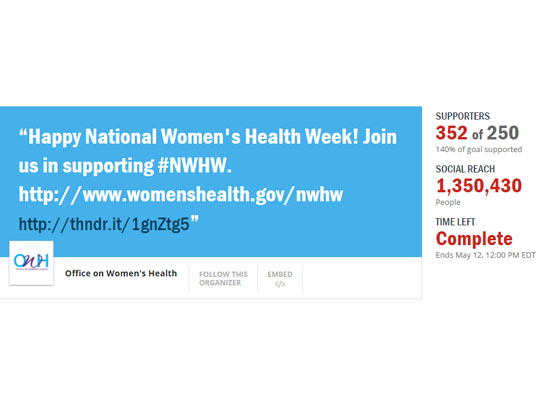You’ve Hosted the Thunderclap, Now Measure the Storm

If you’re a social media manager or social media enthusiast, you’ve probably heard of Thunderclap. Just in case you’re not familiar with the term: a Thunderclap is a social media tool that individuals and organizations can use to amplify a particular message.
ThunderclapExit Disclaimer describes itself as a “crowd-speaking platform.” To use it, organizations or individuals who want to promote a message, event, or call to action create a Thunderclap landing page, draft a message, and set a goal for the number of supporters they hope to engage.
Supporters have to sign up and give permission for the Thunderclap to access their social media accounts (Facebook, Twitter, or Tumblr), which allows the platform to automatically deliver the pre-written message to all of their friends/followers at a specified date and time, without the need for them to do anything more. This only happens if the original goal for supporters is met; if not, the message isn’t sent.
Several federal agencies and community organizations have found the Thunderclap tool to be an effective way to make their voices heard. In fact, the HHS Office on Women’s Health (OWH) hosts two Thunderclaps each year: National Women’s Health Week and National Women and Girls HIV/AIDS Awareness Day. Each year, OWH has set a goal of 250 supporters for these Thunderclaps—a goal they have surpassed every time!
Similarly, the National Center for HIV/AIDS, Viral Hepatitis, STD, and TB Prevention (NCHHSTP), Centers for Disease Control and Prevention (CDC) has also engaged in successful Thunderclap efforts, because they’re a good way to get everyone to pay attention to one message at the same time. NCHHSTP routinely hosts or participates in Thunderclaps as part of observances led by its divisions and many of its partners. One example is this past February’s National Black HIV/AIDS Awareness Day (NBHAAD)Exit Disclaimer Thunderclap to support the activities of the Strategic Leadership CouncilExit Disclaimer. In addition to gaining awareness, the group built an action into the Thunderclap by including a link and driving traffic to the CDC’s HIV Risk Reduction Tool.
Thunderclaps are a powerful way to share your message and get noticed on social media. However, just like any social media initiative, they use some of your valuable resources, like your team’s time and energy. Given the amount of work it takes to plan and execute a successful Thunderclap, you’ll want to measure your effort and show a return on investment (ROI).
There are a few ways to measure the success of your Thunderclap, according to Digital Gov:
- If you reach your engagement goal, your message will be shared by your supporters at the same time. This metric is pretty simple, but the first way to measure success: did you reach your supporter goal? If you did, your message was released and viewed!
- Social reach: How many people were exposed to your message? Thunderclap will display the post’s reach, based on the number of participants, in the Thunderclap platform. The reach of a Thunderclap is equal to the number of supporters who sign up, plus the sum total of all of their friends/followers. You’ll want to use this number to demonstrate the post’s reach.
- The action point: Did people take the desired action? (Sign up, order, etc.) What was your Thunderclap’s call to action? Maybe you were hoping to generate some email sign-ups or new followers. You’ll want to define your call to action before the Thunderclap, and track this call to action after the Thunderclap is over.
- Did you increase traffic to relevant webpages? You can use your website’s analytics after a Thunderclap to understand if the posts drove traffic to your site.
When it comes to measurement, OWH uses both the supporter metric and reach metric to gauge their post’s success. In addition to supporter count and reach, NCHHSTP also tracked traffic to the CDC’s HIV Risk Reduction Tool, which was the call-to-action in their Thunderclap.
“It’s important to first establish what you are trying to accomplish with a Thunderclap, and then determine which metrics you’ll track,” said Michael Runestad, Health Communication Science Office, NCHHSTP. “For our Thunderclap, we wanted to drive traffic to our online tool, so we tracked unique visits to the tool following the Thunderclap.”
For organizations interested in dipping their toes into the Thunderclap waters, OWH recommends finding unique ways to promote the Thunderclap and gain supporters. Reaching out to partners, directly or through email marketing, is key to gaining supporters. The organization also recommends keeping a close eye on the Thunderclap platform in order to track supporter metrics.
As you move forward with your Thunderclap efforts, remember to define metrics of success and develop a measurement plan. And one word of caution: while Thunderclaps are a good way to make sure your message is heard, try to be picky about when you host a Thunderclap. Hosting them too frequently could result in audience burnout
As always, if you’d like support launching a Thunderclap or have any additional new media questions, please sign up for our Virtual Office Hours.